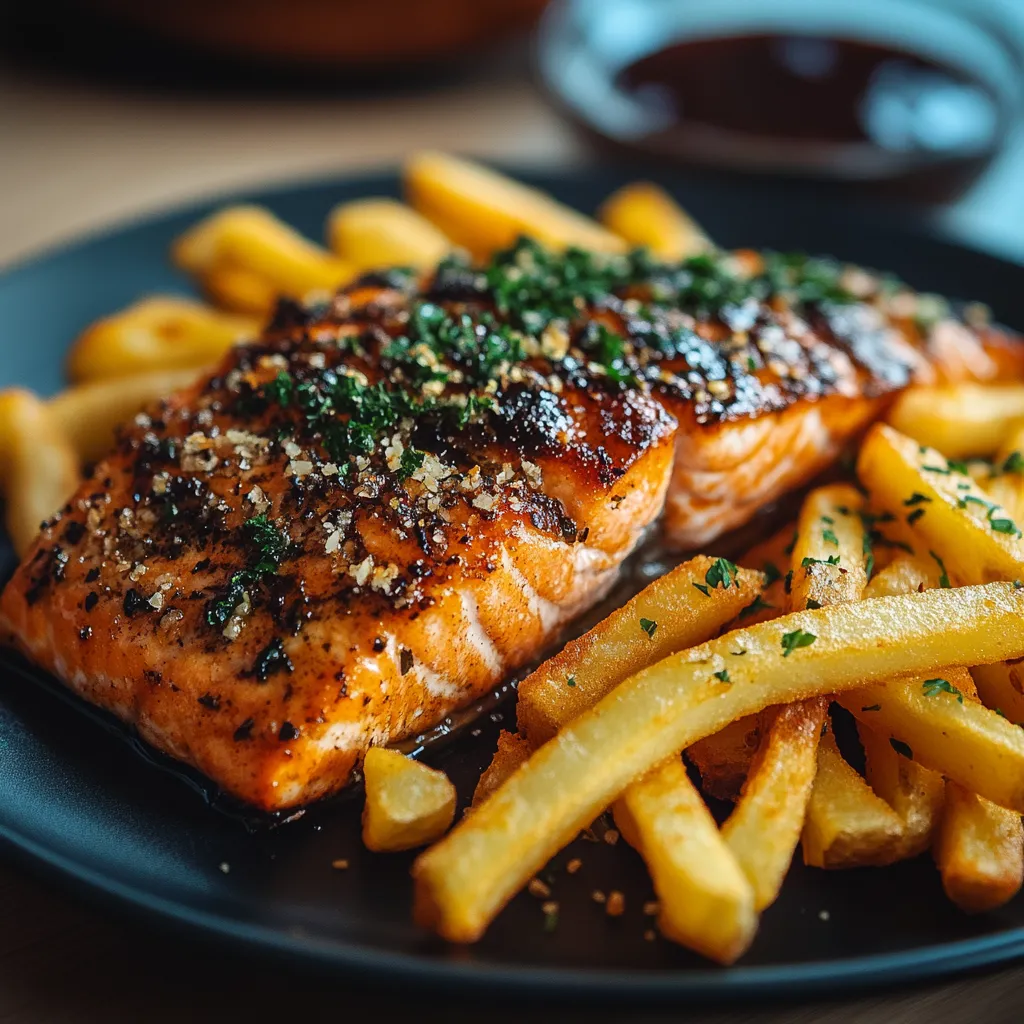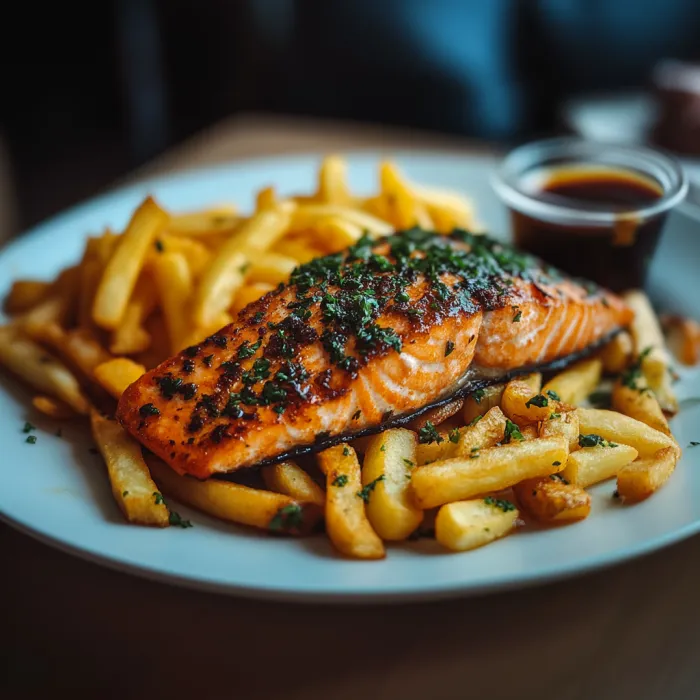 Save
Save
This crispy salmon with french fries combines two beloved classics into one satisfying meal that delivers restaurant-quality results at home. The contrast between the crackling salmon skin and flaky fish paired with golden, twice-fried potatoes creates a plate that's as visually appealing as it is delicious.
I discovered this combination years ago when trying to recreate my favorite bistro dish, and it's since become my go-to impressive dinner when I want to treat myself without spending hours in the kitchen.
Ingredients
- Skin-on salmon fillets fresh wild-caught provides the best flavor and texture, but any quality salmon works beautifully
- Olive oil helps create that golden crust on the salmon without burning
- Salt and freshly ground black pepper the classic seasonings that enhance without overpowering
- Garlic powder adds subtle depth to the salmon without the risk of burning that fresh garlic brings
- Lemon wedges the acidity cuts through the richness of the salmon
- Fresh dill or parsley adds bright color and herbaceous notes
- Russet potatoes their high starch content creates the perfect crispy exterior and fluffy interior
- Vegetable oil its high smoke point makes it ideal for deep frying
Step-by-Step Instructions
- Prepare the Fries
- Cut potatoes into even sticks about a quarter inch thick for consistent cooking. Accuracy matters here as differently sized fries will cook unevenly. Soaking the cut potatoes in cold water for a full 30 minutes removes excess starch that would otherwise prevent proper crisping. After soaking, thoroughly pat them dry before frying since any remaining moisture will cause dangerous oil splatters.
- First Fry
- Heat your oil to exactly 350°F using a kitchen thermometer for precision. This first fry at a lower temperature cooks the potatoes through without browning them too quickly. Fry in small batches to maintain oil temperature, removing when they're just barely golden.
- Second Fry
- After all batches have gone through the first fry, increase your oil temperature to 375°F. This second, hotter fry creates that satisfying crunch. Work quickly but carefully, removing the fries when they reach a deep golden brown. Season immediately while hot so the salt adheres properly.
- Prepare the Salmon
- Pat your fillets completely dry with paper towels. Moisture is the enemy of crispy skin. Season both sides generously with your salt, pepper, and garlic powder, pressing the seasonings gently into the flesh.
- Cook the Salmon
- Heat your olive oil until it shimmers but doesn't smoke. Place the salmon skin-side down and press gently with a spatula for the first 30 seconds to prevent curling and ensure even contact with the pan. Resist the urge to move the salmon prematurely letting it develop that coveted crust.
- Flip and Finish
- When the skin is crackling and golden, carefully flip the salmon. The second side needs less time, just enough to kiss the heat while keeping the center moist. Look for a medium center that's just turning opaque.
- Plate with Purpose
- Position your salmon skin-side up to showcase its crispy texture. Arrange the fries thoughtfully rather than simply piling them on the plate. Add your herb garnish and lemon wedge just before serving for the freshest presentation.
 Save
Save
My absolute favorite part of this recipe is that moment when the salmon skin transforms from soft to shatteringly crisp in the pan. It reminds me of my grandmother teaching me to cook fish properly, saying "patience makes perfect" as we'd wait for that magical transformation to happen.
Perfect Temperature Guide
Achieving the ideal doneness for salmon can be tricky. For medium-rare, look for an internal temperature of 120°F, which will continue rising slightly after removing from heat. Medium salmon reaches 125-130°F and appears mostly opaque but still glistens with moisture in the center. Remember that carryover cooking will continue after removing from heat, so slightly undercooking is preferable to overcooking.
Troubleshooting Fries
The most common mistake when making french fries at home is overcrowding the frying pot. This drops the oil temperature dramatically, resulting in soggy, oil-soaked potatoes instead of crispy fries. Work in smaller batches than you might think necessary. Another pitfall is skipping the soaking step. Those 30 minutes remove excess starch that would otherwise prevent proper crisping. If your fries still turn out soggy, your oil likely wasn't hot enough check with a thermometer next time.
Customization Options
While this classic preparation is perfect as is, you can easily adapt it to your preferences. For spicier fries, toss them with cajun seasoning immediately after frying. The salmon can be enhanced with a honey dijon glaze applied during the last minute of cooking. For a healthier twist, the potatoes can be oven-baked after parboiling, though the texture will differ slightly from deep-fried versions. A squeeze of lemon and a sprinkle of fresh herbs before serving brightens everything beautifully.
Recipe FAQs
- → Why soak the potatoes before frying?
Soaking the potatoes in cold water for 30 minutes removes excess starch, which is crucial for achieving crispy fries. The starch can cause the fries to stick together and prevents them from getting properly crispy during frying.
- → Why fry the potatoes twice?
The double-frying method is essential for perfect french fries. The first fry at a lower temperature (350°F) cooks the interior, while the second fry at a higher temperature (375°F) creates the crispy exterior. This technique results in fries that are fluffy inside and crispy outside.
- → What's the secret to crispy salmon skin?
For crispy salmon skin, ensure the fillets are completely dry before cooking, use a hot pan with enough oil, and cook skin-side down first. Pressing gently on the fillet helps the skin make full contact with the pan. Resist the urge to flip too early - allow it to cook until the skin is golden and crisp.
- → How do I know when salmon is properly cooked?
Properly cooked salmon should be just opaque throughout and flake easily with a fork. For medium doneness, cook until the internal temperature reaches 125-130°F. The salmon will continue cooking slightly after being removed from heat. Avoid overcooking as this will dry out the fish.
- → What can I serve with this dish besides lemon wedges?
While lemon wedges add brightness, you could also serve this dish with a homemade tartar sauce, aioli, or a simple herb butter. For added vegetables, consider a light side salad, steamed asparagus, or sautéed spinach to complement the rich salmon and crispy fries.
- → Can I prepare any components ahead of time?
You can peel and cut the potatoes up to 24 hours ahead, storing them in cold water in the refrigerator. The first fry can also be done in advance - after the initial frying, let the potatoes cool completely, then refrigerate. Complete the second fry just before serving. The salmon should be cooked fresh for the best texture and flavor.
